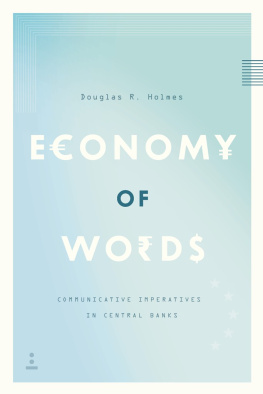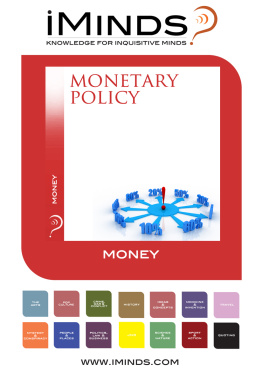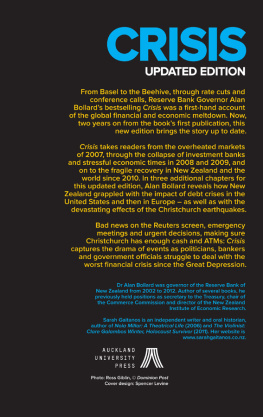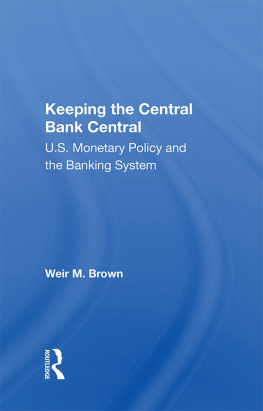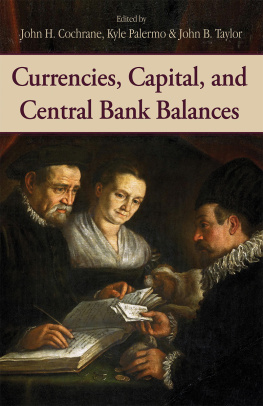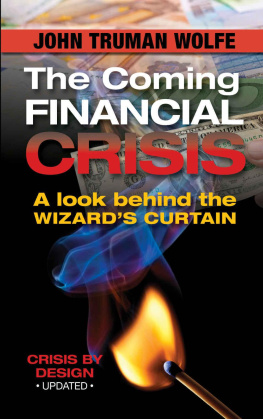The Yale Program on Financial Stability Series
TUMULTUOUS TIMES
CENTRAL BANKING IN AN ERA OF CRISIS

MASAAKI SHIRAKAWA


Published with assistance from the Yale Program on Financial Stability.
Copyright 2021 by Masaaki Shirakawa.
Originally published as Ch gink: Sentoraru bank no keiken shita 39 nen (The Central Bank: My 39 Years as a Central Banker), Tokyo: Toyo Keizai, copyright 2018 by Masaaki Shirakawa.
All rights reserved.
This book may not be reproduced, in whole or in part, including illustrations, in any form (beyond that copying permitted by Sections 107 and 108 of the U.S. Copyright Law and except by reviewers for the public press), without written permission from the publishers.
Yale University Press books may be purchased in quantity for educational, business, or promotional use. For information, please email (U.K. office).
Designed by Sonia L. Shannon.
Set in Minion Pro and Gotham Display by Westchester Publishing Services.
Library of Congress Control Number: 2021934646
ISBN 978-0-300-25897-4 (hardcover: alk. paper)
A catalogue record for this book is available from the British Library.
This paper meets the requirements of ANSI/NISO Z39.48-1992 (Permanence of Paper).
Prologue
THE DAY AFTER
Thursday, March 21, 2013, was a sunny day. The cherry blossoms came out early that year, and I wanted to see them. The Koishikawa Botanical Garden, a miraculous expanse of greenery in the middle of Tokyo, is close to our apartment and my favorite place to take a walk. My wife joined me, and after we enjoyed the cherry blossoms, just then beginning to flower, we stopped at a kiosk and asked for two ice creams, 250 yen each. When I took a 500-yen coin from my pocket to pay, the woman behind the counter, who was probably of my generation, refused to accept it. Governor Shirakawa, I presume, she said. I thank you so much for your five years of service. Today I cannot take your money. She also offered us cups of warm coffee to go with the ice creams. During my tenure as governor of the Bank of Japan I made it a rule not to accept even the smallest gifts so as to avoid any appearance of impropriety. That day I tried to do the same, but I was so moved by the womans sincere kindness that I broke my rule and accepted her gift.
The previous day, my last as governor of the bank, had been a whirlwind. I had appeared before the Financial Affairs Committee of the House of Representatives of the National Diet, gone around to the many offices in the bank to say goodbye to my colleagues and staff, and held my final press conference. The next day, there I was sitting on a park bench with my wife, relishing the sense of fulfillment that comes when you have finished a challenging job.
My five years as governor had been filled with turbulence. Each day I felt as if I was running as fast as I could into a strong headwind. When I finally crossed the finish line, I was so grateful for that act of kindness from the ice cream vendor in the Koishikawa Botanical Garden.
AN ACCIDENTAL GOVERNOR
Winding back the clock a little more than five years, to 9:00 A.M. on March 11, 2008, I was in the National Diet Building to deliver my statement of intent before the Rules and Administration Committees of both the House of Representatives (the lower house) and the House of Councilors (the upper house). The cabinet of Prime Minister Yasuo Fukuda had nominated me to be deputy governor of the Bank of Japan, and both houses of the Diet needed to hear from me before giving their consent to my appointment. In the committee rooms, I spoke after Toshiro Muto, the current deputy governor of the Bank of Japan, who had been nominated to be governor. After reading my prepared statement, I concluded, If I am given the honor of serving at the Bank of Japan, at a time when Japan is being subjected to significant changes both economically and financially, I will sincerely devote my heart and soul to discharging my duties.
After we had answered the committees questions, the outcome of their deliberations was most unusual. While the lower house of the Diet was under the control of the prime ministers Liberal Democratic Party (LDP), the upper house was under opposition control of Democratic Party of Japan (DPJ), and this, being unusual in Japan, created a convoluted and awkward political climate. While the lower house gave its consent to the promotion of Muto to the position of governor, and also to the appointment of another deputy governor, the upper house declined to give its consent. As a result, only my appointment was approved by the Diet. Even before the votes were counted, press reports had speculated that the promotion of Muto would be blocked, that the office of governor would remain vacant, and that one of the deputy governors would have to become the acting governor. Postwar Japan had never seen such a situation, and I found it hard to imagine that this could happen.
On March 18, just one business day before the term of governor Toshihiko Fukui was to expire, the cabinet nominated a former Ministry of Finance official as governor and nominated Kiyohiko Nishimura, a Policy Board member of the Bank of Japan and a former professor at the University of Tokyo, to be deputy governor. Again, consent for the nomination for governor was not forthcoming from the upper house, just as in the case of Muto, even as Nishimuras nomination was given consent. Only days before I was to be formally appointed on March 21 as deputy governor, it dawned upon me that I would in fact become the acting governor when I became deputy governor.
Before my appointment I received precious advice from two former governors. One was an inspirational telephone call from Yasushi Mieno, the twenty-sixth governor, who told me to be humble but bold. The other was from outgoing governor Fukui, when we had the handover of the governors functions. His advice was also important but more practical: Dont ever catch a cold.
On March 21, I went to the Diet Building, where Prime Minister Fukuda presented me with my letter of appointment as deputy governor. Following a series of brief courtesy visits with key members of the ruling and opposition parties, I finally entered the bank. While I had worked at the bank for thirty-four years, retiring in 2006 as an executive director, I had never anticipated becoming governor or even acting governor under such extraordinary circumstances. It was not to be business as usual for the accidental governor.
After two hectic weeks, on the evening of April 2, Finance Minister Fukushiro Nukaga called me at home to ask me, informally, if I would be willing to accept appointment as governor. While I do not know what was discussed within the government that led to my nomination as governor, in addition to the byzantine political situation in Japan at the time, the decision was also likely influenced by the fragile international financial environment. Just a few weeks earlier, on March 16, the Federal Reserve Bank of New York had provided emergency funding to JPMorgan Chase to support its purchase of troubled Bear Stearns. While financial markets seemed to be in a lull, anxieties had not been dispelled. With a meeting of the G7 finance ministers and central bank governors in Washington, DC, scheduled for mid-April, many influential commentators argued that, given the unsettled markets, it would be inappropriate for Japan to participate in the G7 meeting without a governor of the Bank of Japan.
Next page

